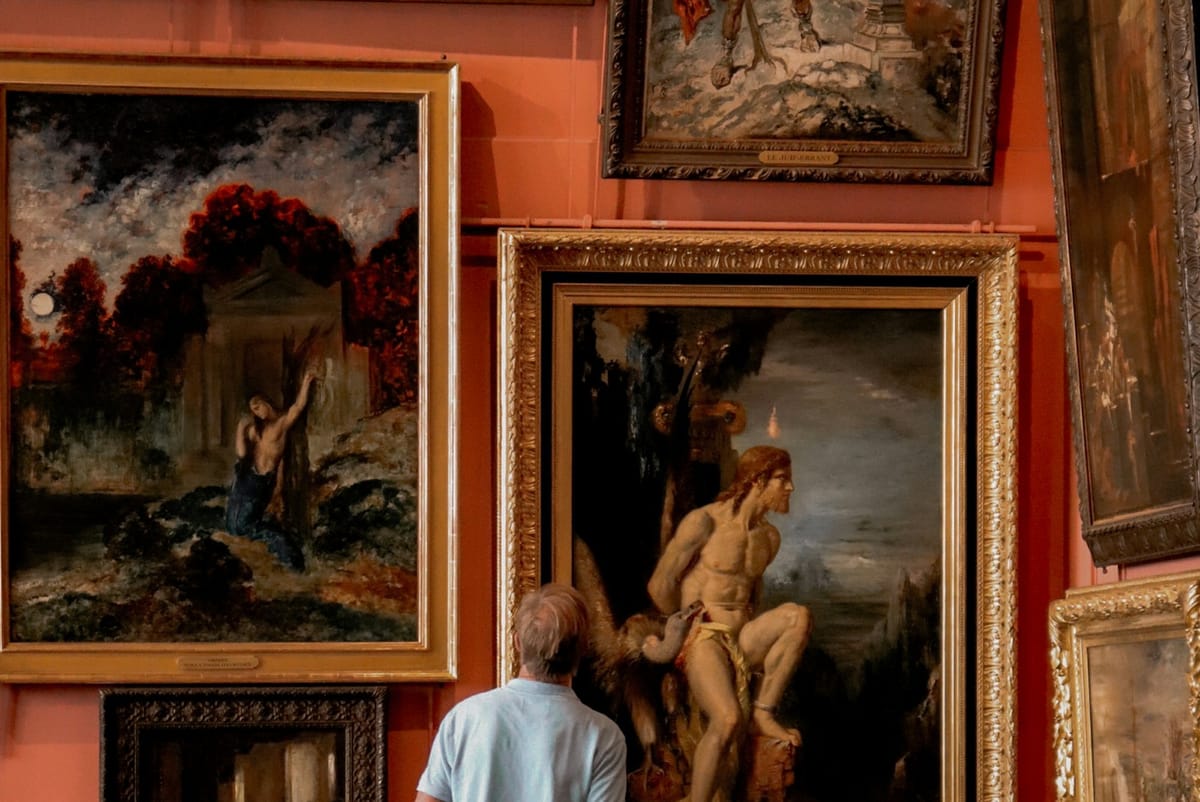How to Analyze a Painting: Elements and Principles of Art
Unlock the mysteries behind great paintings with our guide to art analysis. Explore the elements and principles of art that artists use to create compelling works, and enhance your appreciation and understanding of their masterpieces.

Art analysis is an enriching practice that deepens our understanding and appreciation of visual art. It involves looking beyond the surface of a painting to explore the techniques, elements, and principles that contribute to its overall impact. This guide aims to equip you with the knowledge and skills to analyze paintings effectively, enhancing your experience as an art enthusiast.
Understanding the Elements of Art
The elements of art are the building blocks used by artists to create a work of art. They are the visual components that, when combined, produce the final piece. These elements include line, shape, form, colour, value, space, and texture.
1. Line
Lines are fundamental to art. They can be straight, curved, thick, thin, solid, or broken, and they play a crucial role in guiding the viewer’s eye through a painting.
- Types of Lines: Horizontal lines can create a sense of calm or stability, vertical lines suggest height and strength, and diagonal lines imply movement or tension.
- Function: Lines can outline shapes, create textures, or convey motion. They are also used to suggest depth and perspective.
2. Shape and Form
Shapes are two-dimensional, defined by boundaries such as lines or colour changes, whereas forms are three-dimensional, adding depth to shapes.
- Geometric Shapes: Circles, squares, and triangles are precise and often evoke a sense of order.
- Organic Shapes: These are irregular and free-flowing, often found in nature, and can convey spontaneity and natural beauty.
- Forms: Forms include spheres, cubes, and pyramids, which can be rendered through shading and perspective to appear three-dimensional.
3. Colour
Colour is one of the most expressive elements of art, capable of evoking emotions and setting moods.
- Hue: The name of a colour (red, blue, yellow, etc.).
- Value: The lightness or darkness of a colour. High value (lighter colours) can convey light and space, while low value (darker colours) can create depth and shadow.
- Intensity: The brightness or dullness of a colour. High-intensity colours are vivid and eye-catching, while low-intensity colours are muted and subtle.
- Colour Relationships: Complementary colours (opposite on the colour wheel) create high contrast and visual interest, while analogous colours (next to each other on the colour wheel) offer harmony and cohesion.
4. Value
Value refers to the lightness or darkness of a colour, crucial for creating depth, contrast, and emphasis.
- High Key: A painting with predominantly light values, often conveying a cheerful or airy atmosphere.
- Low Key: Dominated by dark values, giving a somber or dramatic feel.
5. Space
Space in art refers to the illusion of depth within a painting. It can be positive (the subject itself) or negative (the background).
- Perspective: Techniques such as linear perspective (converging lines) and atmospheric perspective (changes in colour and clarity) help create the illusion of three-dimensional space on a two-dimensional surface.
- Overlapping: Placing one object over another to suggest depth.
- Size Variation: Smaller objects appear further away, while larger objects seem closer.
6. Texture
Texture is the perceived surface quality of a work of art. It can be actual (tactile) or implied (visual).
- Actual Texture: The physical texture of the paint on the canvas, which can be felt.
- Implied Texture: The illusion of texture created by the artist through techniques like brushwork or the application of different materials.
Exploring the Principles of Art
The principles of art are the rules and guidelines that artists use to organize the elements of art in their works. These principles include balance, contrast, emphasis, movement, pattern, rhythm, and unity.
1. Balance
Balance refers to the distribution of visual weight in a painting, creating a sense of stability.
- Symmetrical Balance: Elements are evenly distributed on either side of a central axis, often creating a formal and orderly appearance.
- Asymmetrical Balance: Different elements are balanced according to their visual weight, creating a more dynamic and interesting composition.
- Radial Balance: Elements radiate from a central point, common in circular compositions.
2. Contrast
Contrast involves the juxtaposition of differing elements to create visual interest and emphasis.
- Colour Contrast: Using complementary colours to create vibrant contrasts.
- Value Contrast: High contrast between light and dark values to draw attention to certain areas.
- Texture Contrast: Combining smooth and rough textures to enhance visual interest.
3. Emphasis
Emphasis is used to highlight the most important parts of a painting, directing the viewer’s attention to focal points.
- Focal Point: The area where the artist wants the viewer to focus, often achieved through contrasting colours, lines, or unique shapes.
- Isolation: Placing an element alone to make it stand out.
- Placement: Positioning elements strategically within the composition to draw attention.
4. Movement
Movement guides the viewer’s eye through the painting, creating a sense of action or flow.
- Directional Lines: Lines that lead the eye in a specific direction.
- Rhythm: Repetition of elements to create a visual tempo.
- Implied Movement: Suggesting motion through dynamic compositions and lines.
5. Pattern
Pattern involves the repetition of elements or motifs within a painting to create rhythm and unity.
- Regular Patterns: Predictable and orderly repetition, often creating a sense of calm and stability.
- Irregular Patterns: Unpredictable repetition, adding visual excitement and complexity.
6. Rhythm
Rhythm is the visual tempo created by repeating elements, akin to the beat in music.
- Regular Rhythm: Evenly spaced repetitions, creating a steady and calm effect.
- Alternating Rhythm: Alternating patterns or motifs, adding variety and interest.
- Progressive Rhythm: Gradual changes in the repeated elements, suggesting growth or movement.
7. Unity and Harmony
Unity and harmony are the overall sense of cohesion and coherence in a painting.
- Colour Harmony: Using a consistent colour palette to unify the composition.
- Repetition: Repeating shapes, lines, or colours to create a sense of harmony.
- Proximity: Grouping related elements together to suggest a relationship.
Practical Steps to Analyze a Painting
Now that we’ve covered the fundamental elements and principles of art, let’s apply this knowledge to analyze a painting.
Step 1: Observation
Begin with a thorough observation of the painting. Take your time to notice the details and overall composition.
- First Impressions: What is your immediate reaction to the painting? What stands out to you?
- Subject Matter: What is depicted in the painting? Is it a landscape, portrait, abstract, or still life?
Step 2: Description
Describe the painting using the elements of art.
- Line: What types of lines are used? How do they guide your eye?
- Shape and Form: Identify the shapes and forms present. Are they geometric or organic?
- Colour: Analyze the colour scheme. What hues, values, and intensities are used?
- Value: Describe the range of lightness and darkness. Where are the lightest and darkest areas?
- Space: How is space used to create depth? Is the perspective accurate?
- Texture: Describe the texture. Is it actual or implied?
Step 3: Analysis
Analyze how the principles of art are applied to organize the elements.
- Balance: How is balance achieved? Is it symmetrical or asymmetrical?
- Contrast: Identify areas of contrast. How do they create emphasis?
- Emphasis: Where is the focal point? How is it achieved?
- Movement: How does your eye move through the painting? What elements create movement?
- Pattern and Rhythm: Identify any patterns or rhythms. How do they contribute to the composition?
- Unity and Harmony: How do the elements work together to create a unified whole?
Step 4: Interpretation
Interpret the meaning and message of the painting.
- Artist’s Intent: What do you think the artist is trying to convey? Consider the title and context.
- Emotional Response: How does the painting make you feel? What emotions or thoughts does it evoke?
- Symbolism: Identify any symbols or metaphors. What might they represent?
Step 5: Evaluation
Evaluate the painting based on your analysis and interpretation.
- Success: Do you think the painting successfully achieves the artist’s intent? Why or why not?
- Personal Opinion: What is your personal opinion of the painting? Do you like it or not? Explain your reasons.
Conclusion
Analyzing a painting is a rewarding practice that enhances your appreciation and understanding of art. By carefully observing the elements and principles used by artists, you can gain insight into their techniques and intentions. Whether you are a seasoned art enthusiast or a beginner, these steps will help you engage more deeply with the art you encounter, fostering a richer and more informed experience.





